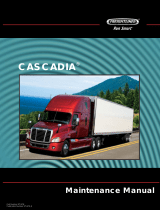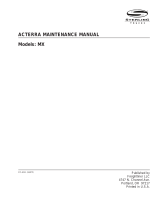
2
If, in the case of an emergency or for some other reason the
driver wishes an application of the trailer brakes, he pulls
the PP-3
™
valve control button out. Emergency line pressure
will exhaust out the PP-3
™
valve exhaust port causing an
application of the trailer brakes. Also, the TP-3
™
inlet valve
seats and closes the service line. The PP-3
™
valve button is
pulled out and left out during bob-tailed operation of the tractor.
In normal use the button is pulled out before uncoupling
from the trailer and pushed in after coupling to the trailer.
Should a condition occur resulting in air loss from the tractor
or trailer system through leakage and the driver fails to
manually pull out the PP-3
™
valve button, the PP-3
™
valve
will automatically close at approximately 40 psi and seal
the tractor air lines. The driver cannot, in this condition,
overcome the emergency application of the trailer brakes by
holding the PP-3
™
valve button in. If the driver should hold
the button in as emergency line pressure bleeds down from
the 40 psi range to approximately 30 psi, the tripper piston
will move and open the tripper exhaust in the PP-3
™
valve.
Emergency line air will exhaust through the tripper exhaust
and hold the trailer brakes applied.
PREVENTIVE MAINTENANCE
Important: Review the Bendix Warranty Policy before
performing any intrusive maintenance procedures. A warranty
may be voided if intrusive maintenance is performed during
the warranty period.
No two vehicles operate under identical conditions, as a
result, maintenance intervals may vary. Experience is a
valuable guide in determining the best maintenance interval
for air brake system components. At a minimum, the PP-3
™
valve should be inspected every 12 months or 3600 operating
hours, whichever comes first, for proper operation. Should
the PP-3
™
valve not meet the elements of the operational
tests noted in this document, further investigation and service
of the valve may be required.
OPERATING AND LEAKAGE CHECKS
To make the following operating and leakage checks, an
accurate test gauge installed in a spare hose coupling is
required. The vehicle dash gauge should be checked for
accuracy against the test gauge prior to making these tests.
1. Block and/or hold the vehicle by a means other than air
brakes during these tests.
2. Drain vehicle reservoir supply, then close drain cocks.
3. Connect assembled hose coupling and test gauge in
tractor emergency hose coupling. Start engine and build
up system pressure.
4. As reservoir pressure builds up there should be no
pressure reading on test gauge. When system pressure
reaches the 30 to 40 psi range on dash gauge make
and hold a foot or hand valve application and observe
that no air escapes at the open trailer service hose
coupling.
5. When system pressure reaches approximately 60 psi,
the PP-3
™
valve button should be pushed in. System
pressure should show at once on the test gauge
connected in the emergency line and the button of the
PP-3
™
valve should remain in without being held.
6. Build system pressure up to approximately 100 psi, then
stop engine. With engine stopped, wait momentarily,
then notice that dash gauge and test gauge pressure
reading equal. While still in this position, make a foot or
hand valve application and observe that air is delivered
out the open trailer service coupling.
7. With PP-3
™
valve button still in, check for leakage at
PP-3
™
valve exhaust and tripper exhaust ports. Leakage
should not exceed a 1" bubble in 5 seconds at either
point.
8. With PP-3
™
valve button still in, check for leakage at the
TP-3
™
valve exhaust and open service coupling. Leakage
should not be more than a 1" bubble in 5 seconds at
either point.
9. Pull the PP-3
™
valve button out: pressure on the test
gauge connected in the emergency line should drop to
zero. Make and hold a hand valve application and observe
that air delivered at the open service coupling does not
exceed a 1" bubble in 5 seconds. Release foot or hand
valve application.
NOTE: If the PP-3
™
valve does not function as described
or if leakage is excessive, it is recommended that it be
returned to the nearest Bendix authorized distributor for
a factory rebuilt valve. If this is not possible, the valve
should be repaired using genuine Bendix parts, in which
case the following should prove helpful.
REMOVING AND INSTALLING
REMOVING
1. Block and/or hold the vehicle by a means other than air
brakes. Drain air brake system.
2. Disconnect supply and delivery lines from PP-3
™
valve.
3. Drive out PP-3
™
valve button roll pin and remove button.
Remove PP-3
™
valve mounting nut, then PP-3
™
valve.
INSTALLING
When installing the PP-3
™
valve, refer to Figure 2 for proper
connections along with following explanations:
1. Supply line from tractor reservoir is connected to supply
port of PP-3
™
valve.
2. Delivery line from PP-3
™
valve delivery port is connected
to tractor emergency port of TP-3
™
valve.
3. PP-3
™
valve exhaust port and tripper exhaust must be
open.
4. Two (2) ports marked “Del” on upper PP-3
™
control valve
body are plugged and must remain plugged.




 1
1
 2
2
 3
3
 4
4





